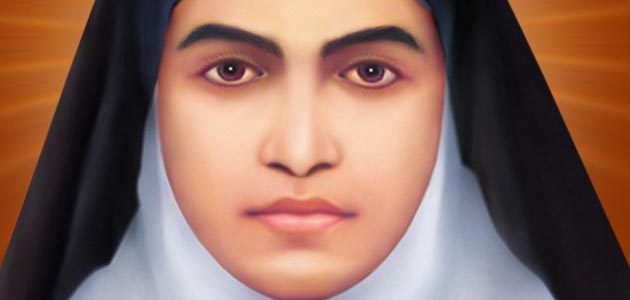History of St. Alphonsa
 Saint Alphonsa Muttathupadathu, F.C.C., or Saint Alphonsa of the Immaculate Conception (19 August 1910 – 28 July 1946) was a Syro-Malabar Catholic Franciscan Religious Sister who is now honored as a saint. She is the first person of Indian origin to be canonized as a saint by the Catholic Church and the first canonized saint of the Syro-Malabar Catholic Church, an Eastern Catholic Church of the Saint Thomas Christian community. Early life She was born Anna Muttathupadathu, the fourth child of Cherian Ouseph and Mary Muttathupadathu, in Kudamalloor, near Kottayam, on 19 August 1910. She was baptized on the following 26 August. Alphonsamma, as she was locally known, was born in Arpookara, a village in the princely state of Travancore, which was under the British Raj at the time.
Saint Alphonsa Muttathupadathu, F.C.C., or Saint Alphonsa of the Immaculate Conception (19 August 1910 – 28 July 1946) was a Syro-Malabar Catholic Franciscan Religious Sister who is now honored as a saint. She is the first person of Indian origin to be canonized as a saint by the Catholic Church and the first canonized saint of the Syro-Malabar Catholic Church, an Eastern Catholic Church of the Saint Thomas Christian community. Early life She was born Anna Muttathupadathu, the fourth child of Cherian Ouseph and Mary Muttathupadathu, in Kudamalloor, near Kottayam, on 19 August 1910. She was baptized on the following 26 August. Alphonsamma, as she was locally known, was born in Arpookara, a village in the princely state of Travancore, which was under the British Raj at the time.
Today the place is called Kottayam District, within the state of Kerala, India. This lies within the Archdiocese of Changanassery.Her parents nicknamed her Annakkutty (little Anna) She had a poor, difficult childhood and experienced loss and suffering early on in life. Anna’s mother died when she was young, so her maternal aunt raised her. Hagiographies describe her early life as one of suffering at the hands of her stern foster mother and the teasing of schoolchildren. Anna was educated by her great-uncle, Father Joseph Muttathupadathu.
When Anna was three years old, she contracted eczema and suffered for over a year. In 1916 Anna started school in Arpookara. She received her First Communion on 27 November 1917. In 1918, she was transferred to a school in Muttuchira. In 1923, Anna’s feet were burnt when she fell into a pit of burning chaff; local hagiographies describe this as a self-inflicted injury in order to avoid her foster mother’s attempt to arrange a marriage for, and thereby to fulfill her desire for becoming a Religious Sister instead. This accident left her permanently disabled.
When it became possible, Anna joined the Franciscan Clarist Congregation, a religious congregation of the Third Order of St. Francis, and through them, completed her schooling. Anna arrived at the Clarist convent at Bharananganam, Kottayam district, on Pentecost Sunday 1927. She received the postulant’s veil on 2 August 1928, and in May 1929 was assigned to teach at Malayalam High School at Vazhappally. Her foster mother died in 1930. Three days later she resumed her studies at Changanacherry, while working as a temporary teacher at a school at Vakakkad. On 19 May 1930 Anna entered the novitiate of the congregation at Bharananganam and received the religious habit, taking the religious name of Alphonsa of the Immaculate Conception at that time. On 11 August 1931, she completed the novitiate and took her first vows.
Sister Alphonsa took her permanent vows on 12 August 1936. Two days later she returned to Bharananganam from Changanacherry.Sister Alphonsa then taught high school at St. Alphonsa Girl’s High School, but was often sick and unable to teach. For most of her years as a Clarist Sister she endured serious illness.In December 1936, it is claimed that she was cured from her ailments through the intervention of the Blessed Kuriakose Elias Chavara (who was beatified at the same ceremony as she), but on 14 June 1939 she was struck by a severe attack of pneumonia, which left her weakened. On 18 October 1940, a thief entered her room in the middle of the night. This traumatic event caused her to suffer amnesia and weakened her again.Her health continued to deteriorate over a period of months. She received extreme unction on 29 September 1941. The next day it is believed that she regained her memory, though not complete health.
Her health improved over the next few years, until in July 1945 she developed a stomach problem that caused vomiting.She died on 28 July 1946, aged 35. She is buried at Bharananganam, Travancore (present day Kerala) in the Diocese of Palai.During the last year of her life she came to know the later-Bishop of Kerala Sebastian Valopilly, a priest at the time, who frequently brought her communion. This bishop became famous in Kerala for championing the cause of poor people from all religious backgrounds who had come to live Thalassery as a result of shortages elsewhere. He was also the person who reported the miracle attributed to St. Alphonsa’s intercession.
Source: http://saintalphonsachurchmundur.org/node/2
